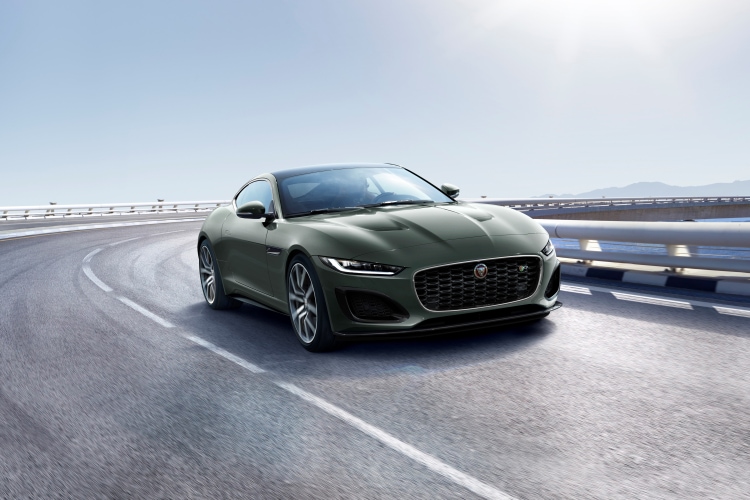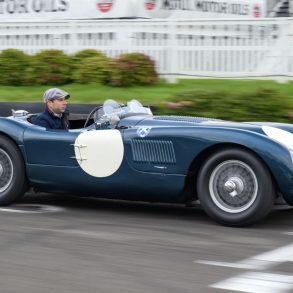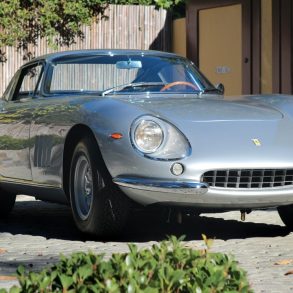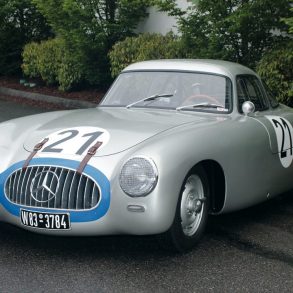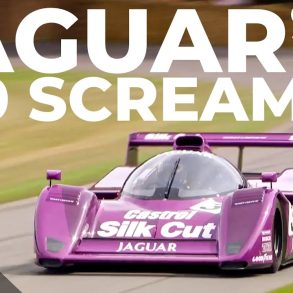Who owns Jaguar in 2021? Discover the current owner of the luxury vehicle manufacturer along with the past owners since inception.
When it comes to somewhat affordable yet undeniably luxurious sports cars, Jaguar is among the first brands, if not the first, to spring to everyone’s mind. It is a quintessentially British automaker renowned for its rich history of desirable sports cars, sports sedans, and worldwide racing success.
Recently, Jaguar’s traditional lineup was complemented by F-Pace and E-Pace SUVs and the i-Pace EV. While the brand is now flourishing, it had a tumultuous history, and we’re here to answer many important questions regarding it, starting with who owns Jaguar today.

Who owns Jaguar in 2021?
As of 2021, the Jaguar brand is under Jaguar Land Rover Automotive PLC, a wholly-owned subsidiary of Tata Motors Limited registered in Great Britain. Jaguar’s stocks aren’t publicly traded, but Tata Motors Limited is listed on the New York Stock Exchange, Bombay Stock Exchange, and the National Stock Exchange of India.
Now, knowing that Tata Motors owns Jaguar, let’s look into the jaguar history of ownership from its inception to this day:
1922-1934 Swallow sidecar company, William Walmsley and William Lyons
Given that Jaguar is known for its luxurious, sporty executive sedans and high-performance sports cars, it’s hard to imagine that the company had much humbler beginnings.
The company we now know as Jaguar was founded in 1922 by two passionate motorcyclists from Blackpool, William Walmsley, and William Lyons. In the years after WW1, Walmsley converted military motorcycles for street use and made motorcycle sidecars, while Lyons was a fellow Blackpudlian and a satisfied customer.
Lyons took an interest in Walmsley’s business, and the two soon formed Swallow Sidecar Company of Blackpool in 1922, just after Lyons turned 21, becoming of legal age. The duo built airstreamed octagonal sidecars, growing their business to automotive body repairs with the expansion of the British car manufacturing industry in the north.
In the following years, the company became known as Swallow Side Car & Coach Building Co, mainly due to its work on affordable Austin Seven chassis. Swallow-bodied Austins were slightly upmarket compared to builds by other companies, making a name for Lyons and Walmsley, so the expansion was imminent.

In 1928, Swallow Side Car & Coach Building Co moved to a more extensive facility in Coventry, where it diversified its range to Fiat and Standard cars, among others. In 1931, Lyons presented the SS I, the company’s first wholly original car, a low sports coupé, followed by the SS-II and a growing range of motor cars.
1934-1945 S.S. Cars Limited, William Lyons, Shareholders
The company’s growth led William Lyons to form S. S. Cars Limited, while William Walmsley was content to let the company go and expand further. On January 11, 1934, Lyons bought the shares from Walmsley, becoming the Chairman and Managing Director of the company.
In 1935, S.S. Cars presented the SS Jaguar range, consisting of two sedans with a 2.5-liter and a 1.5-liter engine and a SS Jaguar 100 sports car. Lyons’ business was doing well until 1939 when WW2 broke out, first slowing down the production and then halting it in 1940.

During the wartime years, S.S. Cars Limited helped Britain’s efforts through repairing bomber planes and manufacturing military-spec sidecars for the Royal Army.
1945-1966 Jaguar Cars Limited, William Lyons, Shareholders
The aftermath of WW2 saw SS Cars Limited changing its name to Jaguar after its distinguished sports car, the SS 100 Jaguar. The obvious reason for changing the name was the fact that SS initials became inseparably associated with Nazi Germany’s notorious elite forces, the Schutzstaffel.
The meeting between Lyons and other shareholders took place in March 1945. By rebranding the company, William Lyons set out on a new mission under a unique identity to give the recovering markets the fastest road and track machinery. In 1948, Lyons presented the Jaguar XK120, the first road vehicle to break the 120 MPH barrier, and on the race tracks, Jaguar dominated sports car racing with its C-Type and D-Type cars.

Robin Adams ©2019 Courtesy of RM Sotheby’s
All those triumphs were courtesy Jaguar XK engine, a brainchild of William Heynes, Walter Hassan, and Claude Baily. The trio envisioned the engine during WW2, making the concept production-ready for Jaguar Mark V, the company’s first post-WW2 car.
After reaching its racing zenith in the mid and late 1950s, Jaguar lost ground on Le Mans but remained on top by introducing a superb Mark II Sedan in 1959 and one of the greatest sports cars ever created, the magnificent Jaguar E-Type in 1961. Meanwhile, the company’s founder was knighted in 1956.

A year before the E-Type saw the light of day, William Lyons bought Daimler from BSA, and the sub-brand became oriented towards mature customers looking for luxury and comfort over sports spirit.
1966- British Motor Holdings Limited
For Jaguar and Lyons, the mid-50s were also marked by several tragedies, both personal and business-related. En route to the catastrophic 1955 24 Hours of Le Man’s race, William’s son John Lyons was killed in a car crash, and two years later, a fire in Browns Lane Jaguar factory crippled the production for several months also destroying several XKSS cars.
Getting closer to retirement age and with no one to succeed him, Lyons started contemplating the future of his company. Big companies like Ford, Vauxhall, Rootes Group, Leyland, and British Motoring Corporation were making moves across the industry, and Lyons saw the future in merging with one of them.
When BMC bought Jaguar’s body shell manufacturer, Pressed Steel Company Ltd, in 1965, Lyons made a move towards Leyland but was unhappy with the outcome as he was demanded to give up control over Jaguar.
So, in 1966, Jaguar merged with British Motor Corporation in a joint holding company named British Motor Holdings Limited. Sir George Harriman was named the chairman while Sir Lyons was a director. Sir Lyons remained under the control of Jaguar Cars Ltd. as a chairman. Before the merger, Sir Lyons held 59,25% of voting shares: 260,000 of 450,000 available.
1968-1975 British Leyland Motor Corporation
In late 1967, a merger between British Motor Corporation and Leyland Motor Corporation became imminent, which eventually happened on May 14, 1968. In November the same year, Lyons appointed Lofty England as Deputy Chairman.

In 1972, Sir Lyons became director of the British Leyland UK Ltd., retiring from Jaguar Cars Ltd. Given his very close, almost autocratic involvement in Jaguar, Sir Lyons was still overseeing all matters within the company.
1975-1982 State Ownership
Years of bad management took its toll on the whole British Leyland, but Jaguar witnessed the most significant fall as it suffered through aging jaguar models lineup, inadequate quality, and loss of brand identity.
In 1975, the conservative Labour Government nationalized British Leyland as per the Ryder Report. Sir Don Ryder restructured the company into British Leyland Limited by buying out the stock via the National Enterprise Board.
In this restructuring plan, Jaguar became a part of an upmarket Jaguar Rover Triumph division in 1977, courtesy of Michael Edwardes, a new chief executive appointed by the National Enterprise Board.
1982-1989 Jaguar Car Holdings
Further changes within British Leyland saw Jaguar diversifying from the JRT division, with Sir John Egan appointed in 1982. Under Egan, Jaguar completed the final design overseen by Sir William Lyons – the XJ40.

In August 1984, Jaguar’s entire share capital of 177.9 million shares was offered on the London Stock Exchange, garnering unprecedented interest from institutional and small investors. Jaguar became an independent, privately led company. Sir John Egan remained at the company’s head and was quick to sort burning issues, bringing Jaguar back on track.
Sir Lyons was able to witness his company’s renaissance, albeit for a short time, as he died on February 8, 1985, a year before the XJ40 was introduced to the public.
1989-2008 Ford Motor Company
In the 1980s, Ford Motor Company needed a luxurious European brand under its wing to battle with the likes of BMW and Mercedes-Benz. Finally, after failed negotiations with Alfa Romeo and SAAB, Ford managed to snatch Jaguar in 1989 before General Motors did.
The negotiations with shareholders started in 1989 and finished on February 28, 1990, when Jaguar Car Holdings was taken off from the LSE. The acquisition cost Fo Mo Co $2.5 billion, and it came at an unfortunate time as the market was hit by an economic recession, which also caused the XJ220 supercar to be a commercial flop.

Under Ford, Jaguar modernized its woefully aging Jaguar vehicle lineup, waving goodbye to the XJ40 and XJ-S, cars replaced by more modern XJ X300 and XK8 in 1994 and 1996, respectively. In addition to developing the all-new flagship XJ sedan, Ford introduced other Jaguar models in the shape of S-Type and the X-Type, two cars sharing platforms with other Fo Mo Co products, namely the Lincoln LS and the Ford Mondeo, respectively. Thanks to these two retro-modern cars, Jaguar grew but didn’t record any profits.
In 1999, Ford Motor Company restructured Jaguar under the Premier Automotive Group alongside Volvo and Aston Martin. The brand was reunited with Rover and Land Rover in 2000 when the Blue Oval bought the brands from BMW.
(2008-Today) Tata Motors – Jaguar Land Rover
In mid-2007, Ford Motor Company revealed its plans of selling Jaguar and Land Rover. Among interested parties were Mahindra&Mahindra, several private equity firms, and Tata Group.

On January 18, 2008, India’s Tata Motors founded Jaguar Land Rover Limited to act as a holding company for the acquisition. The sale went through on March 26, 2008, Tata Motors acquired Jaguar and Land Rover, as well as Daimler, Rover, and Lanchester brands from Ford at the price of $2.3 billion.
Until 2013, Jaguar operated as Jaguar Cars Limited, a brand separate from Land Rover. Starting from January 1, 2013, Jaguar Land Rover Limited became Jaguar Land Rover Automotive PLC. All Land Rover assets merged with Jaguar Cars Limited assets, giving birth to Jaguar Land Rover Limited.

As you can see, when looking into who owns Jaguar, the company has had several owners throughout the decades. However, Tata Motors is the current owner of the luxury car manufacturer.


